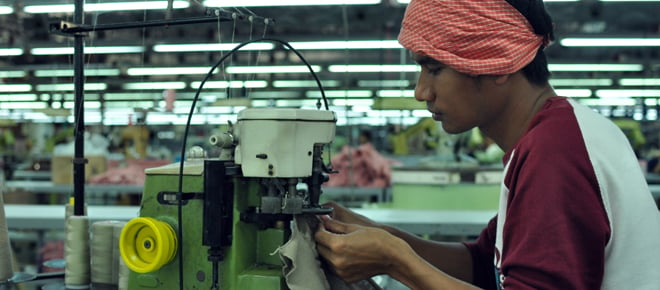Cambodia: enjoying China’s long shadow
As China’s growth raises wages, Cambodians get more business
Share

With per capita GDP well under a thousand dollars and a government dependent on foreign aid, Cambodia is among the poorest of the poor in Southeast Asia. But with workers in China, Thailand and Vietnam, demanding and obtaining heftier paychecks, Cambodians are getting a residual lift. Rising wages, labour unrest, as well as currency instability and political turmoil in some cases, elsewhere in the region’s traditional manufacturing centers are improving the prospects of Cambodia, an industrial minnow.
The country’s garment exports have soared in the past year, increasing by nearly 40 per cent, according to the government. Independent observers might put the figure lower, but they would agree with Ken Loo, the secretary general of the Garment Manufacturers Association of Cambodia, when he points to rising wages and work stoppages in China as one of the main causes of Cambodia’s increased share of the market. It’s an important boost in a sector that has been Cambodia’s main engine of growth since the late 1990s, when the country stabilized after years of debilitating civil strife. The garment and footwear industry employs some 400,000 people in this country of just over 14 million (the Gap, H&M and Nike are among the major brands that have suppliers in Cambodia) and account for more than two-thirds of Cambodia’s exports.
But the spillover effects of higher labour costs in China and elsewhere aren’t limited to the textiles sector. Slowly but surely, Cambodia’s industrial horizons are expanding as well, with Japanese companies leading the charge. Minebea, a Tokyo-based producer of micro motors, for example, started operations in Cambodia at the end of last year. The Japanese company began outsourcing manufacturing to Thailand 25 years ago, where it has grown to employ over 30,000 workers. Because of rising wages there, it’s now assembling some of its products in a special economic zone in Phnom Penh, Cambodia’s capital. Other manufacturers—making headphones and wetsuits, among other products—have opened plants there too, lifting the sophistication of the Cambodian manufacturing sector above T-shirts and sneakers.
“It’s unrealistic to say Cambodia is adding huge value-added chains,” said Peter Brimble, chief economist of the Asian Development Bank in Cambodia. But growing hurdles in Asia’s main production centers are “enough to tip the scales” to attract investor interest in Cambodia. Gordon Peters, an investment adviser with Emerging Markets Consulting, which operates in Southeast Asia, said the number of international companies contacting his consulting firm about business scoping opportunities in Cambodia has grown exponentially this year. More investors are looking at Cambodia as an attractive “long-term bet,” one with limited dividends now but high-growth prospects in the near future, he said.
Observers often criticize the heavy-handed influence of Beijing on Cambodia. But if rising wages in the regional powerhouse can lift business and employment prospects in Cambodia, this is a spell under China’s shadow that the Southeast Asian country is likely to enjoy.
Brendan Brady (www.brendanbrady.com) reports widely on diplomacy, business, human rights and environmental issues across the Asia-Pacific.